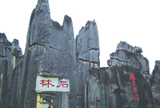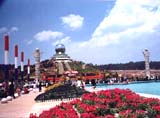Kunming Major Events & Festivals Kunming's
biggest festival is the International Horticulture Exposition.
But visitors will also find celebrations for all of the other major
Chinese National Holidays, as well as many cu ltural festivals
held throughout the year by the various Chinese ethnic minority
groups residing in Kunming and Yunnan. Kunming's
biggest festival is the International Horticulture Exposition.
But visitors will also find celebrations for all of the other major
Chinese National Holidays, as well as many cu ltural festivals
held throughout the year by the various Chinese ethnic minority
groups residing in Kunming and Yunnan.
Yunnan is also famous for the different types of festivals celebrated in the province. Kunming Tourist Festival Since Kunming is home to various Chinese ethnic minority groups, a Tourist Festival is held every April 10 to May 10 promoting tourism throughout Yunnan Province as well as within Kunming. This festival brings foreign tourists together from different parts of the world, all dressed up in oriental style and participating in all types of Chinese activities. The festival features performances and activities in Kunming downtown and local scenic spots where attract tourists from all over the world may also see various exhibitions, see shows, and taste local foods. Kunming Torch Festival
Water Splashing of Dai Festival The 3rd Month Fair Bai people are diligent, simple and honest, admire the color of white ( Bai in Chinese means white ). The main festival is the large-scale "The 3rd Month Fair ". Originally, this festival was called Avalokitesvara's Festival. It was Avalokitesvara who opened up the Dali area, subdues Monster Luocha and brought prosperity to the people. Every year from the fifteenth to the twentieth of the third lunar month, people gather at the Triple-Pagodas Temple to pay homage and express thanks to Avalokitesvara. Along with the economic development, trade becomes brisk at the gathering, Finally it has become a yearly fair. In addition to trading commodities, there are horse racing, performance of operas, folk singing and dancing. Other Festivals in Kunming The Chinese minority groups in Yunnan also sponsor many smaller festivals throughout the year in Kunming, especially from March to October. Some of the festivals include the Knife-Pole Festival of Lisu in March, and the Golden Temple Fair.
The Exposition focused mainly on exhibiting plants and flowers.
There were displays covering the various traditional horticultural
and gardening arts and styles of various nations, the achievements
of international environmental protection, the history of horticulture
and the role of horticulture in the development of society. |

 The
Torch Festival also takes place in Yunnan Province, on the 24th
day of the 6th lunar month. The Kunming Torch Festival is held
in the eroded limestone pillars of the Stone Forest which provides
the backdrop for the traditional sports and celebrations. Events
include horseracing, bullfighting, cockfighting, traditional dance
displays, a torch parade and a bonfire party.
The
Torch Festival also takes place in Yunnan Province, on the 24th
day of the 6th lunar month. The Kunming Torch Festival is held
in the eroded limestone pillars of the Stone Forest which provides
the backdrop for the traditional sports and celebrations. Events
include horseracing, bullfighting, cockfighting, traditional dance
displays, a torch parade and a bonfire party.  The International Horticulture Exposition 1999 held in Kunming
was a large-scale exposition with the theme of "Humanity
and Nature--Advancing Towards the 21st Century". The theme
centered around horticulture and how plants and flowers help to
make the environment more enjoyable.
The International Horticulture Exposition 1999 held in Kunming
was a large-scale exposition with the theme of "Humanity
and Nature--Advancing Towards the 21st Century". The theme
centered around horticulture and how plants and flowers help to
make the environment more enjoyable. 
